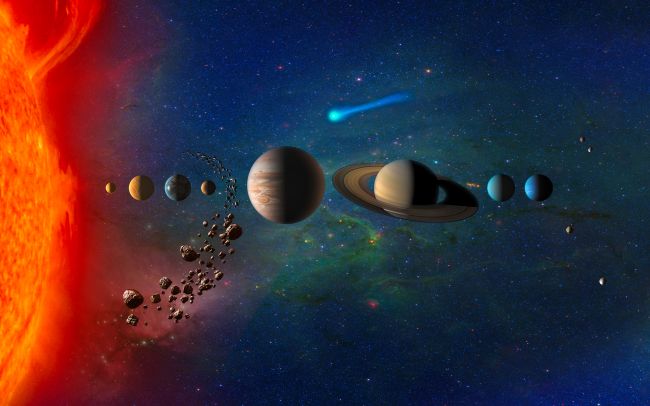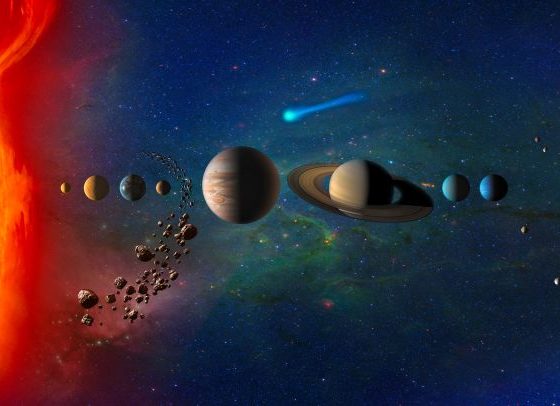

News
NASA’s next mission could study one of these bizarre moons
Venus, Triton, or Io? Where would you send NASA’s newest mission?
The space agency is in the midst of planning out its next Discovery class mission, a lower cost exploration program, capped at $500 million (not including launch costs). To that end, NASA has selected four finalists and one — or perhaps two — will ultimately be chosen from the quartet to make it to the launch pad.
“These selected missions have the potential to transform our understanding of some of the solar system’s most active and complex worlds,” Thomas Zurbuchen, associate administrator of NASA’s Science Mission Directorate, said in a statement Thursday (Feb. 13), when the finalists were announced.
“Exploring any one of these celestial bodies will help unlock the secrets of how it, and others like it, came to be in the cosmos,” he added.
The teams behind the four mission concepts will each receive $3 million to continue developing their ideas over the next nine months. NASA officials will then evaluate the prospects and select up to two missions for continued development.
In previous years, many of the choices were either very asteroid heavy or Mars centric. But this year, its Venus’ turn. Two of the four mission concepts are all about exploring Earth’s so-called hellish twin.

The DAVINCI Plus (Deep Atmosphere Venus Investigation of Noble gases, Chemistry and Imaging Plus) mission would send a probe down through the thick Venusian air, in an effort to better understand how the planet’s atmosphere has changed over time.
The VERITAS (Venus Emissivity, Radio Science, InSAR, Topography and Spectroscopy) mission would map Venus’ surface in detail from orbit. These measurements would help scientists deduce whether or not Venus has plate tectonics as we see on Earth and if there are active volcanoes on the planet’s surface.
Shifting the focus to another volcano world, the Io Volcano Observer (IVO) mission, would focus on the Jovian moon, Io, and observe it up close through a series of close flybys.
We know that Io’s volcanism is driven in part by the other Galilean moons pulling and tugging on the rocky moon, which keeps its insides churning. But what researchers don’t know is exactly how these tidal forces affect the evolution of rocky bodies. Here’s where IVO comes in.

Lastly, there’s the Trident mission. This mission would be set up similar to the New Horizons flyby of Pluto in 2015. The spacecraft would fly by Neptune’s largest moon, Triton, and study is up close, mapping the surface and trying to gauge whether or not the moon is hiding a subsurface ocean.
You can learn more about all four finalists here.
Established in 1992, NASA’s Discovery Program has supported the development and implementation of over 20 missions and instruments. Some of those missions include the Kepler space telescope, the Mars InSight Lander, the Dawn spacecraft that explored the dwarf planet Ceres and many more.

News
Tesla FSD fleet is nearing 7 billion total miles, including 2.5 billion city miles
As can be seen on Tesla’s official FSD webpage, vehicles equipped with the system have now navigated over 6.99 billion miles.

Tesla’s Full Self-Driving (Supervised) fleet is closing in on almost 7 billion total miles driven, as per data posted by the company on its official FSD webpage.
These figures hint at the massive scale of data fueling Tesla’s rapid FSD improvements, which have been quite notable as of late.
FSD mileage milestones
As can be seen on Tesla’s official FSD webpage, vehicles equipped with the system have now navigated over 6.99 billion miles. Tesla owner and avid FSD tester Whole Mars Catalog also shared a screenshot indicating that from the nearly 7 billion miles traveled by the FSD fleet, more than 2.5 billion miles were driven inside cities.
City miles are particularly valuable for complex urban scenarios like unprotected turns, pedestrian interactions, and traffic lights. This is also the difference-maker for FSD, as only complex solutions, such as Waymo’s self-driving taxis, operate similarly on inner-city streets. And even then, incidents such as the San Francisco blackouts have proven challenging for sensor-rich vehicles like Waymos.
Tesla’s data edge
Tesla has a number of advantages in the autonomous vehicle sector, one of which is the size of its fleet and the number of vehicles training FSD on real-world roads. Tesla’s nearly 7 billion FSD miles then allow the company to roll out updates that make its vehicles behave like they are being driven by experienced drivers, even if they are operating on their own.
So notable are Tesla’s improvements to FSD that NVIDIA Director of Robotics Jim Fan, after experiencing FSD v14, noted that the system is the first AI that passes what he described as a “Physical Turing Test.”
“Despite knowing exactly how robot learning works, I still find it magical watching the steering wheel turn by itself. First it feels surreal, next it becomes routine. Then, like the smartphone, taking it away actively hurts. This is how humanity gets rewired and glued to god-like technologies,” Fan wrote in a post on X.
News
Tesla starts showing how FSD will change lives in Europe
Local officials tested the system on narrow country roads and were impressed by FSD’s smooth, human-like driving, with some calling the service a game-changer for everyday life in areas that are far from urban centers.

Tesla has launched Europe’s first public shuttle service using Full Self-Driving (Supervised) in the rural Eifelkreis Bitburg-Prüm region of Germany, demonstrating how the technology can restore independence and mobility for people who struggle with limited transport options.
Local officials tested the system on narrow country roads and were impressed by FSD’s smooth, human-like driving, with some calling the service a game-changer for everyday life in areas that are far from urban centers.
Officials see real impact on rural residents
Arzfeld Mayor Johannes Kuhl and District Administrator Andreas Kruppert personally tested the Tesla shuttle service. This allowed them to see just how well FSD navigated winding lanes and rural roads confidently. Kruppert said, “Autonomous driving sounds like science fiction to many, but we simply see here that it works totally well in rural regions too.” Kuhl, for his part, also noted that FSD “feels like a very experienced driver.”
The pilot complements the area’s “Citizen Bus” program, which provides on-demand rides for elderly residents who can no longer drive themselves. Tesla Europe shared a video of a demonstration of the service, highlighting how FSD gives people their freedom back, even in places where public transport is not as prevalent.
What the Ministry for Economic Affairs and Transport says
Rhineland-Palatinate’s Minister Daniela Schmitt supported the project, praising the collaboration that made this “first of its kind in Europe” possible. As per the ministry, the rural rollout for the service shows FSD’s potential beyond major cities, and it delivers tangible benefits like grocery runs, doctor visits, and social connections for isolated residents.
“Reliable and flexible mobility is especially vital in rural areas. With the launch of a shuttle service using self-driving vehicles (FSD supervised) by Tesla in the Eifelkreis Bitburg-Prüm, an innovative pilot project is now getting underway that complements local community bus services. It is the first project of its kind in Europe.
“The result is a real gain for rural mobility: greater accessibility, more flexibility and tangible benefits for everyday life. A strong signal for innovation, cooperation and future-oriented mobility beyond urban centers,” the ministry wrote in a LinkedIn post.
News
Tesla China quietly posts Robotaxi-related job listing
Tesla China is currently seeking a Low Voltage Electrical Engineer to work on circuit board design for the company’s autonomous vehicles.

Tesla has posted a new job listing in Shanghai explicitly tied to its Robotaxi program, fueling speculation that the company is preparing to launch its dedicated autonomous ride-hailing service in China.
As noted in the listing, Tesla China is currently seeking a Low Voltage Electrical Engineer to work on circuit board design for the company’s autonomous vehicles.
Robotaxi-specific role
The listing, which was shared on social media platform X by industry watcher @tslaming, suggested that Tesla China is looking to fill the role urgently. The job listing itself specifically mentions that the person hired for the role will be working on the Low Voltage Hardware team, which would design the circuit boards that would serve as the nervous system of the Robotaxi.
Key tasks for the role, as indicated in the job listing, include collaboration with PCB layout, firmware, mechanical, program management, and validation teams, among other responsibilities. The role is based in Shanghai.
China Robotaxi launch
China represents a massive potential market for robotaxis, with its dense urban centers and supportive policies in select cities. Tesla has limited permission to roll out FSD in the country, though despite this, its vehicles have been hailed as among the best in the market when it comes to autonomous features. So far, at least, it appears that China supports Tesla’s FSD and Robotaxi rollout.
This was hinted at in November, when Tesla brought the Cybercab to the 8th China International Import Expo (CIIE) in Shanghai, marking the first time that the autonomous two-seater was brought to the Asia-Pacific region. The vehicle, despite not having a release date in China, received a significant amount of interest among the event’s attendees.








